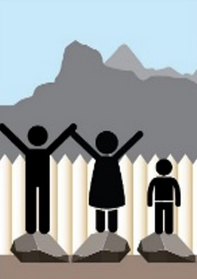Diversity, Equity and Inclusion (DEI) initiatives are currently occupying everyone’s attention since the murder of George Floyd in 2020, and the concept of anti-racism and decolonization became more prominent. However, to start with that, it is important to note that the co-option of racism, diversity and inclusion, social justice and social good does not equate with a conversation on decolonisation. We need to understand the narrative of decolonisation, colonial, localization and the intersection with diversity, equality, and inclusion. Yet they are not the same!
Decolonisation debates did not start in 2020 but started when people in the global south began organizing to counter the ideologies of the oppressors who sought to enforce power and seize land. It is about coming up with a new ‘paradigm’ of thinking and approach that interrogates the post-colonial agenda provides agency to the ‘local’ that has a pedagogy of liberation and freedom that works in partnership with the affected community. It is about disrupting the system and upending the structure according to and with local voices, cultures and traditions. It is about taking the risk and having the right actors at the table to hear their voices.
The conversations around DEI focus on the need to provide for inclusive participation. Inclusive participation is about understanding that power imbalances in all societies mean that some people experience more privilege. Those same power imbalances mean that many other people experience more violence, discrimination and exclusion than others. Some of the most prominent examples of power imbalances have been expressed through racism, xenophobia, colonialism, sexism, homophobia and other forms of entrenched oppression that remain rampant globally.
This means getting a better understanding of the intersectionality of identities. Individuals have several layers to their identities. Gender, ethnic origin, nationality or citizenship, age, disability, language, political opinions, religious beliefs, social background, sexual orientation, physical appearance and colour that “intersect” – or are “woven” together.
People suffer discrimination against a combination of these factors. An intersectional perspective emphasizes the importance of looking at these forms of discrimination together and at the same time in order to understand their compound effects on the individual.
At the heart of the inclusive, participative approach is an analysis of not only how pre-existing inequalities and differences lead to vulnerabilities, capacities, risks and levels of exposure to harm; for different people but how the intersectionalities of identities (such as people’s gender, disability, age, ethnic origin, nationality or citizenship, language, religious beliefs, political opinion, social background, sexual orientation, physical appearance and colour) impact the level of barriers they face in their efforts to meet basic needs, to be recognized and included, and to be safe from harm. Considering these factors and how they interrelate is central to looking at immediate risks and consequences of exclusion and violations and the causes of those risks.
Thus the central concept of inclusive participation is the emphasis on the equality and dignity of each human being and the humanitarian imperative to not discriminate against any single one – including acknowledging that if we do not adapt our work and approach to the different needs of different people, and we do not model the diversity of the community we serve, we are in fact discriminatory!!

1
This paradigm shift in thinking and approach relies on equity which is different to the concept of equality. The latter is based on the assumption that everyone benefits from the same support. This is represented by diagram 1.
However, equity speaks more to the intersectional approach, which speaks to how individuals may need different types of support and approaches based on their varying vulnerabilities in varying degrees in order to benefit from equal outcomes.
Thus, equity leads to equality!! For example, working on equal gender rights means that equitable measures need to be taken to ensure those equal rights are met.
This is represented by diagram 2.

2
Ideally, the scenario from the diagrams is to get rid of the fence altogether, as shown below in diagram 3.

3
This is justice and ultimately the end result of inclusive participation and social inclusion.
Inclusive participation improves the ability, opportunity and dignity of individuals and groups excluded on the basis of their identity to take part in society. Working on social inclusion matters reduces in reducing inequalities based on social backgrounds, identities, roles and power relations. Providing inclusive services means giving equitable access to resources for all. This means that everyone has a role to play. It is not only important that we get people from the ‘minority’ groups to shout louder about getting equitable rights and representation. It is not until their narrative is understood and mainstreamed by the majority that we can actually move the conversation forward. DEI should not be a simple ‘tick box’ exercise but an integral and embedded process that takes into account power dynamics, identities, possibilities and vulnerabilities across societies.
We need to do better; we need to be better, not because it is the good thing to do, but the right thing to do, to treat people with dignity, respect and humanity. This is our moral responsibility. Put simply, diversity is a fact, and inclusion is an act!!!



